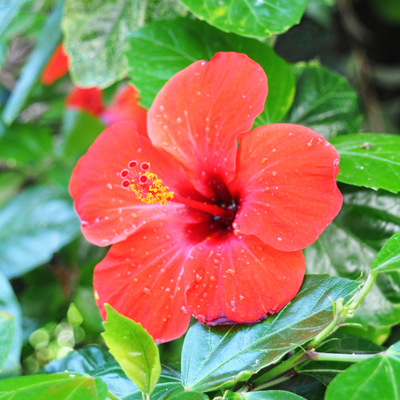Quick facts
- Hibiscus flowers are beautiful but short-lived, usually in bloom for only one day.
- A rich, well-drained soil mixture is ideal.
- Hibiscus needs warm temperatures to bloom.
- Prune in late winter to encourage a bushier plant.
- Common problems include yellow leaves, flower buds dropping and insect pests.
The hibiscus is a member of the mallow family which has nearly 300 species including trees, shrubs, perennials and annuals. They are native to warmer, tropical regions.
In our northern climate, Hibiscus rosa-sinensis is the species most commonly available through nurseries, garden centers and florists. Hibiscus are bred specifically for flower size and color.
The beautiful, exotic-looking flowers are short-lived, typically blooming for only one day. Once finished blooming, the flower will close up and drop off. There is also a shell-like structure supporting the flower. This too withers and drops a few days after the flower fades.
Hibiscus make great house plants and are also wonderful additions to a summer garden. They are not winter hardy, and therefore must be brought in before the first fall frost.
Hibiscus are easy plants to grow and should pose few problems if their needs are met.
Growing hibiscus
Soil
- A rich, well-drained soil mixture is ideal.
- Recommended potting mix for hibiscus:
- 2 parts potting soil
- 2 parts peat moss
- 1 part perlite or vermiculite
Temperature
- Hibiscus does not tolerate cold temperatures. The plant needs warm temperatures for flower buds to develop.
- Grow them indoors in a warm, sunny location where daytime temperatures are no lower than 55°F.
- 65° to 75°F is best.
- If it is too cold, flower buds may drop off or fail to form altogether.
- Hibiscus cannot withstand extreme changes in temperature or humidity.
- Avoid placing them in drafty areas, near radiators, on TVs, or in entryways where they will be blasted with cold air from time to time.
Light
- Hibiscus require very bright light to bloom well indoors.
- A sunny western or southern exposure that has at least 4-5 hours of bright, direct light is best.
- The more light they have, the better they will bloom, indoors or out.
- These plants benefit from being placed outdoors after danger of frost. Before placing them directly in full sun, it is important to acclimate them to the brighter conditions.
- Begin by moving the hibiscus to a porch, then to filtered light under a shade tree and finally into the bright sunlight.
- Reverse the process in the fall so that the plant is indoors before the first frost.
- By easing the plant into different conditions, one can prevent bud loss and minimize foliage loss.
Watering
- Keep the soil relatively moist, not saturated.
- Never allow the soil to dry out to the point of wilting.
- Check the pot to make sure drainage holes are present.
- Water from the top of the soil down so that water runs out the bottom holes.
- This leaches soluble salts from the soil.
- It also ensures that the bottom roots are watered thoroughly.
- Drain off excess water.
- During the winter months, allow the soil to dry out a little more between watering.
Fertilizing
- Hibiscus are heavy feeders and require a balanced fertilizer such as 20-20-20 or 10-10-10.
- Use at half the label recommended strength every 2-3 weeks when placed outside for the summer.
- Indoors, fertilize less often, using ½-strength formulation, every month or so in spring and summer, less frequently in winter.
Pruning
- Prune in late winter to encourage a bushier plant.
- Selectively trim back any leggy growth to the rest of the plant.
- Hibiscus can withstand a heavy pruning. Do not be afraid to give your plant a good haircut, especially if you want to maintain a smaller plant.
- Remember you will be pruning off flower buds in addition to the foliage, so it will take longer to bloom.
Growing from cuttings
The easiest method of propagating these plants is from vegetative cuttings.
- Take 3"-5" cuttings from the strongest shoots available.
- Dip the cut ends in a rooting hormone compound, tap off the excess and stick in a small pot filled with a light potting mixture.
- Keep slightly moist and place in a well lighted area.
- After 3-5 weeks, they should develop a good root system and be ready for transplanting.
- To encourage a bushier plant once the cutting has rooted, cut or pinch off the top inch of stem to just above a leaf node, where a leaf joins the stem.
Common problems
Yellow leaves
- Caused by abrupt changes in soil moisture, air temperature or drafts.
- Avoid excessive watering, especially with older varieties.
- Some yellowing is normal in spring or fall when growing conditions are in transition.
- Yellowing may signal need for fertilizer.
Bud drop
- Caused by the plant being too cold or too hot.
- Hibiscus needs daytime temperatures of 65°F-75°F to develop buds.
- Avoid drafts, too little or too much water and low light conditions.
Pests
- The most common insects are aphids and spider mites.
- Keep foliage clean by washing periodically.
- Use insecticidal soap or insecticides labeled for use on hibiscus if necessary.
CAUTION: Mention of a pesticide or use of a pesticide label is for educational purposes only. Always follow the pesticide label directions attached to the pesticide container you are using. Remember, the label is the law.
Reviewed in 2024


